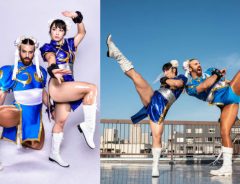Related Article
-

We All Want Someone Who Will Hold Us Like This Adorably Stubborn Cat
-

Century-Old Building Used By The Imperial Japanese Army Is Now A Starbucks
-

Ghibli’s Ohm Looks Outstanding In Sleepy Snowy Weather
-

Japanese Muscle Idol And Ladybeard Team Up For Leggy Chun-li Cosplay
-

Japan’s New Kit Kats Use Premium Sake From Brewery Founded In 1625
-

Astonishing Memo Pads Reveal Intricate Embedded Models The More You Use Them



Furoshiki are traditional Japanese wrapping cloths made to carry clothes, gifts, and other goods. They began being used during the Nara period (AD 710-794) as a way to carry clothes to and from public bathhouses, but are now making a full comeback as eco-friendly, stylish, and extremely versatile cloths made in various fabrics and designs.
The furoshiki can be folded into a wide range of things, including grocery bags and protective hoods to wear during earthquakes. In fact, Japanese YouTuber Isao Yokoyama, also known as the Furoshiki Prince, has an entire YouTube channel dedicated to them, showing viewers different ways they can utilize the cloth.
In this video, he shows us how to wrap up our bento, or lunch boxes, in furoshiki. You can even fold it so that you’ll have a handle to carry it around with in your hand!
The steps are super simple.
First, place the bento in the middle of the cloth.
Source: YouTube
Then, tie all the opposite corners together. You’ll now have a typical wrapped bento.
Source: YouTube
Source: YouTube
For handles, tie single knots on two of the opposing corners of the cloth instead of tying them together in the middle.
Source: YouTube
Tie the knotted corners together.
Source: YouTube
Voila! You have your very own furoshiki bento wrap.
Source: YouTube
Yokoyama writes on his channel that his mission is to “wrap the whole world with furoshiki.” If you want, you can join him on that journey and check out more of his furoshiki videos. But until then, rest assured that you’ll at least be able to pack your lunches to-go in traditional Japanese style.
See the whole tutorial here: